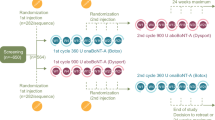Abstract
This study aimed at providing real-life baseline, injection and outcome data for the treatment of various forms of spasticity with onabotulinumtoxin A in Germany. Prospective data were collected in an open multicenter patient registry from 2005 until 2010, encompassing the experience of ten specialized German centers in the treatment of spasticity using onabotulinumtoxin A in 508 patients with a total of 2005 treatment sessions. Disease entities comprised spasticity following stroke (both ischemic and hemorrhagic), traumatic brain injury, multiple sclerosis, cerebral palsy, and anoxia. Sustained improvement was observed in a variety of outcome parameters including goal attainment and motor performance scores for up to five repeated injection sessions. No significant differences between disease entities or between upper and lower limb treatment were observed with regard to efficacy and safety following onabotulinumtoxin A treatment. Minor to moderate side effects were reported in <1 % of the study population. We conclude that repetitive treatment of focal and multifocal spasticity with onabotulinumtoxin A provides a safe and efficacious therapeutic strategy for patients with different disease entities of the central nervous system.

Similar content being viewed by others
References
Bohannon RW (1997) Comfortable and maximum walking speed of adults aged 20–79 years: reference values and determinants. Age Ageing 26:15–19
Collen FM, Wade DT, Bradshaw CM (1990) Mobility after stroke: reliability of measures of impairment and disability. Int Disabil Stud 12:6–9
Ertzgaard P, Ward AB, Wissel J et al (2011) Practical considerations for goal attainment scaling during rehabilitation following acquired brain injury. J Rehabil Med 43:8–14
Esquenazi A, Mayer N, Lee S et al (2012a) Patient registry of outcomes in spasticity care. Am J Phys Med Rehabil 91:729–746
Esquenazi A, Albanese A, Chancellor MB et al (2012b) Evidence-based review and assessment of botulinum neurotoxin for the treatment of adult spasticity in the upper motor neuron syndrome. Toxicon 67:115–128
Kossmehl P, Maertgen C, Kuhle N, Weber E, Mueller-Kuhle R, Speth F, Wissel J (2012) Sensitivity and specificity of standard senso-motor test inventories when applied in the context of post acute neurorehabilitation in patients with spastic paresis after stroke. Neurorehabil Neural Repair 26:395
Lagalla G, Danni M, Reiter F et al (2000) Post-stroke spasticity management with repeated botulinum toxin injections in the upper limb. Am J Phys Med Rehabil 79:377–384
Mehrholz J, Wagner K, Rutte K et al (2007) Predictive validity and responsiveness of the functional ambulation category in hemiparetic patients after stroke. Arch Phys Med Rehabil 88:1314–1319
Mohammadi B, Balouch SA, Dengler R et al (2010) Long-term treatment of spasticity with botulinum toxin type A: an analysis of 1221 treatments in 137 patients. Neurol Res 32:309–313
Podsiadlo D, Richardson S (1991) The timed “Up & Go”: a test of basic functional mobility for frail elderly persons. J Am Geriatr Soc 39:142–148
Wissel J, Ward AB, Erztgaard P et al (2009) European consensus table on the use of botulinum toxin type A in adult spasticity. J Rehabil Med 41:13–25
Wissel J, auf dem Brinke M, Hecht M et al (2011) Botulinum toxin in the treatment of adult spasticity. An interdisciplinary German 10-point consensus 2010. Nervenarzt 82:481–495
Acknowledgments
This study was in part supported by an unrestricted educational grant of Allergan-Germany, Ettlingen. The authors report no conflict of interest with regard to the content of this article.
Axel Schramm, MD, received research grants from Allergan and Ipsen Pharma. He is also a consultant for Ipsen and received compensation for lectures and training courses from Allergan, Ipsen, Merz and Novartis.
Within the framework of this study, Jean-Pierre Ndayisaba received compensation for database maintenance from Allergan.
Matthias auf dem Brinke, MD, received research grants and honoraria for presentations and consulting from Allergan, Merz, Medtronic and Ipsen.
Martin Hecht, MD, received research grants and honoraria for presentations and consulting from Allergan, Merz and Ipsen.
Christoph Herrmann received research grants from Allergan and Otto Bock Healthcare, and also honoraria for lectures from Allergan, Medtronic and Merz.
Martin Huber, MD, received research grants from Allergan and honoraria for lectures from Allergan, Merz, Ipsen and Medtronic.
Elmar Lobsien, MD, has no financial disclosures to make.
Sabine Mehnert, MD, received compensation for lectures and training courses from Allergan, Ipsen and Merz.
Iris Reuter, MD, received compensation for lectures from Allergan, Ipsen, Merz and Novartis.
Christian van der Ven, MD, received research grants and honoraria for presentations and consulting from Allergan, Merz, Medtronic and Ipsen.
Martin Winterholler, MD, received honoraria and grants from Allergan, Ipsen, Merz and Elan.
Andreas Kupsch, MD, received honoraria for lectures from Allergan, Boehringer Ingelheim, Ipsen, Lundbeck, Medtronic, Merck-Serono, Merz, Orion and UCB, consultant compensation for advisory board activity from Medtronic, and grant support from the German Research Council and German Ministry of Education and Research.
Joerg Wissel, MD, received research grants and honoraria for presentations and consulting from Allergan, Merz, Medtronic and Ipsen.
Author information
Authors and Affiliations
Corresponding author
Additional information
The last two authors equally contributed to senior authorship.
Electronic supplementary material
Below is the link to the electronic supplementary material.
Rights and permissions
About this article
Cite this article
Schramm, A., Ndayisaba, JP., auf dem Brinke, M. et al. Spasticity treatment with onabotulinumtoxin A: data from a prospective German real-life patient registry. J Neural Transm 121, 521–530 (2014). https://doi.org/10.1007/s00702-013-1145-3
Received:
Accepted:
Published:
Issue Date:
DOI: https://doi.org/10.1007/s00702-013-1145-3




